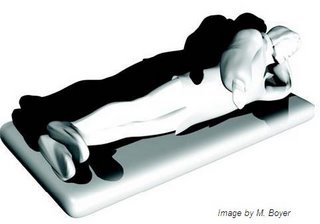 A 22-year-old epilepsy sufferer with no known psychiatric problems has described the eerie feeling that a shadow-like person is mimicking her actions, when really no-one is there. She had the experience when, prior to surgery, Swiss researchers applied electrical probes to the left temperoparietal junction region of her brain. This area is known to be involved in multisensory integration and in distinguishing the self from others.
A 22-year-old epilepsy sufferer with no known psychiatric problems has described the eerie feeling that a shadow-like person is mimicking her actions, when really no-one is there. She had the experience when, prior to surgery, Swiss researchers applied electrical probes to the left temperoparietal junction region of her brain. This area is known to be involved in multisensory integration and in distinguishing the self from others.When the patient was lying down and the probe was applied, she felt as though a figure was behind her. “He is behind me, almost at my body, but I do not feel it”, she said. When she sat upright and embraced her knees, she described the unpleasant sensation that the shadow-like man was now also sitting and was clasping her arms. During a language-task in which she was asked to read out words on cards, she said “He wants to take the card; he doesn’t want me to read”.
The woman’s perceptions resemble those reported by some psychiatric and neurological patients – in particular she didn’t realise the figure was an illusion of her own body – and Shahar Arzy and colleagues concluded their findings may help understand the mechanisms behind experiences like paranoia and alien control. “It is notable that hyperactivity in the temporoparietal junction of patients with schizophrenia may lead to the misattribution of their own actions to other people”, they said.
Incidentally, the practice of exploring brain function in epilepsy sufferers prior to surgery is hardly new – the celebrated Canadian neurosurgeon Wilder Penfield famously charted some of the first somatosensory maps by observing patients’ responses when he stimulated parts of their exposed brain with an electric probe.
__________________________________
Arzy, S., Seeck, M., Ortigue, S., Spinelli, L. & Blanke, O. (2006). Induction of an illusory shadow person. Nature, 443, 287.
Link to related Digest item.
Link to discussion of issues raised by this research.
You have read this article Mental health /
Unusual case studies
with the title Shadow illusion casts light on psychotic experience. You can bookmark this page URL https://psychiatryfun.blogspot.com/2006/10/shadow-illusion-casts-light-on.html. Thanks!





No comment for "Shadow illusion casts light on psychotic experience"
Post a Comment